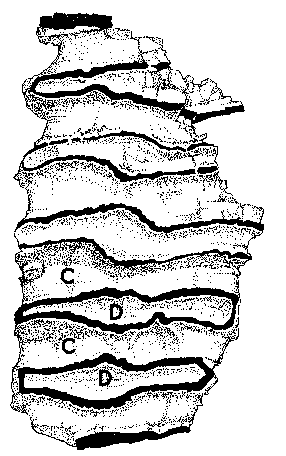A number of orders appear to represent one major clade, the Afrotheria: Afrosoricida, Macroscelidea, Tubulidentata, Hyracoidea, Proboscidea, and Sirenia.
The hyraxes (apparently the "conies" of the Bible) are relatively small creatures (comparable in size to rodents and lagomorphs) that give the impression of being rodent-like in superficial appearance. There are three extant genera with a total of 11 species in the Middle East and throughout most of Africa. They are primarily herbivorous.
Two upper incisors (one on each side) are similar to those of rodents in that they are hypselodont and have enamel only on the anterior surface; A space (diastema) separates them from the four premolars. There are no canines. The analogy with rodents breaks down, however, in the lower jaw, where there are two incisors on each side, unlike the single incisor of rodents (also, no rodent has four premolars). The molars are lophodont. The toes end in almost hoof-like nails. Some other characteristics are shown on the Animal Diversity Web.
The proboscideans consist today of a single family (Elephantidae) that generally has been recognized as consisting of two species, the African (Loxodonta africana) and the Asian (Elephas maximus elephants. Recent work indicates two African species (or possibly even three). The proposed new species (Elephas cyclotis lives in forested areas rather than savannah.
Several species of the genus Mammuthus of this family lasted until about the end of the Pleistocene (and one species apparently lasted on Wrangle Island in the Arctic through most of the Holocene). A separate family (Mammutidae), consisting in the late Pleistocene of North America of a single species, Mammut americanus (the American Mastodon), likewise lasted until the end of the Pleistocene. A third family, the Gomphotheriidae, died out before the very end of the Pleistocene in North America, but survived until late in South America. All three families are represented in the early Pleistocene (Rancholabrean Land Mammal Age) as fossils in the El Paso area.
 The living elephants are the largest living mammals, with a maximum
weight of about 5,900 km. The skeleton is especially adapted for weight bearing (graviportal). There are massive, long limb bones without reduction of ulna or fibula, resulting in columnar
supports. A trunk is characteristic of all of this group, as are tusks formed from the second incisor (many of the earlier taxa had well developed lower tusks as well as uppers).
The living elephants are the largest living mammals, with a maximum
weight of about 5,900 km. The skeleton is especially adapted for weight bearing (graviportal). There are massive, long limb bones without reduction of ulna or fibula, resulting in columnar
supports. A trunk is characteristic of all of this group, as are tusks formed from the second incisor (many of the earlier taxa had well developed lower tusks as well as uppers).
In the Elephantidae, cheek teeth are hypsodont and consist of a number of lamellae (plate-like structures) bound together by cementum; each lamella has a core of dentine and a rim of enamel. The result is an occlusal surface with three different hardnesses of material (soft cementum, harder dentine, and extraordinarily hard enamel) resulting in differential wear ideal for grinding abrasive herbaceous food. The maximum number of such lamellae in the African forms is about 10, whereas the Asiatic species may have over 20. The cheek teeth erupt at the posterior and move forward, rotating so as to bring the rear portion of the tooth into occlusion as the front wears away. Eventually the tooth is worn away as it pushes to the front of the jaw, and the more posterior tooth comes into wear. These teeth are so large that normally only parts of two per jaw are in place at any one time. With a total of six teeth for each jaw, and the last erupting at about age 23, the animal may be able to last beyond an age of 60 with luck before running out of teeth.
Drawing of a fossil tooth of Mammuthus meridionalis, an early mammoth of North America. The black is enamel; "D" indicates dentine and "C" is cementum. From the Resource Collections of the Laboratory for Environmental Biology, Centennial Museum, University of Texas at El Paso.
The sirenians include the dugongs, sea cows, and manatees. These are the only completely aquatic herbivorous mammals. All live in coastal waters of tropical to subtropical nature, both in the Eastern and the Western hemispheres; however, Stellar's Sea Cow, extinct since 1769 due to exploitation by man, inhabited parts of the Bering Sea. The forelimbs are formed into paddles enclosing the five digits. The pelvic girdle is vestigial and there is a horizontal fluke. The replacement pattern of cheek teeth is similar to that of proboscidean, with new teeth pushing in from behind and worn teeth being lost from the anterior of the row. The genus Trichechus, to which the Manatee of Florida and the Caribbean belongs, has the distinction along with the tree sloths of departing from the otherwise universal mammalian trait of seven cervical vertebrate (six for the Manatee).
Last Update: 21 Jan 2008
Centennial Museum and Department of Biological Sciences, The University of Texas at El Paso